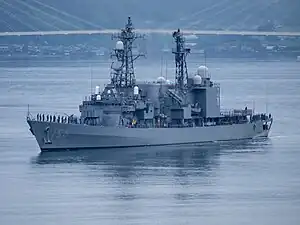JS Setogiri
JS Setogiri (DD-156) is an Asagiri-class destroyer of the Japan Maritime Self-Defense Force.
 JS Setogiri at Maizuru on 2023 | |
| History | |
|---|---|
| Name |
|
| Ordered | 1985 |
| Builder | Hitachi, Maizuru |
| Laid down | 9 March 1987 |
| Launched | 12 September 1988 |
| Commissioned | 14 February 1990 |
| Homeport | Maizuru |
| Identification |
|
| Status | Active |
| General characteristics | |
| Class and type | Asagiri-class destroyer |
| Length | 137 m (449 ft 6 in) |
| Beam | 14.6 m (47 ft 11 in) |
| Draft | 4.5 m (14 ft 9 in) |
| Propulsion | 4 gas turbines 54,000 shp (40,000 kW) |
| Speed | 30 knots (56 km/h; 35 mph) |
| Range | 8,030 nmi (14,870 km; 9,240 mi) at 14 knots (26 km/h; 16 mph) |
| Complement | 220 |
| Sensors and processing systems | |
| Electronic warfare & decoys |
|
| Armament |
|
| Aircraft carried | 1 SH-60J(K) anti-submarine helicopter |
Development and design
The Asagiri class is equipped for combat and interception missions, and is primarily armed with anti-ship weapons. They carry two of the Mk-141 Guided Missile Launching System (GMLS), which are anti-ship missile systems. The ships are also fitted to be used against submarines. They also carry Mk-32 Surface Vessel Torpedo Tubes (SVTT), which can be used as an anti-submarine weapon. The ships have two of these systems abeam to starboard and to port. They are also fitted with an Oto-Melara 62-caliber gun to be used against sea and air targets.[1]
They are 137 m (449 ft 6 in) long. The ship has a range of 8,000 nautical miles (15,000 km; 9,200 mi) at 14 knots (26 km/h; 16 mph) with a top speed of 30 knots (56 km/h; 35 mph). The ship can have up to 220 personnel on board. The ship is also fitted to accommodate for one aircraft. The ship's flight deck can be used to service a SH-60J9(K) Seahawk helicopter.[1]
Construction and career
Setogiri;; was laid down on 9 March 1987 and launched on 12 September 1988 by Hitachi Zosen Corporation, Maizuru. She was commissioned on 14 February 1990.
The destroyer was dispatched to the Great East Japan Earthquake caused by the 2011 off the Pacific coast of Tōhoku Earthquake on 11 March 2011.
On 26 July 2013, she set sail off the coast of Somalia with the escort ship JS Ariake as the 16th dispatched anti-piracy action surface corps. She was engaged in missions until December of the same year and returned to Ōminato on 17 January 2014.[2]
From 19 March to 27 April 2016, the ship participated in the open sea practice voyage (flying) with the escort ship Ariake and the training submarine JS Oyashio on 12 April. At the same time, it is the first Maritime Self-Defense Force ship to call at Cam Ranh Bay, a strategic point in central and southern Vietnam.[3][4]
At around 10:50 pm on 26 August 2017, the SH-60J patrol helicopter on board the ship lost communication during night training. Of the four crew members, one male crew member was rescued after the accident, but the remaining three, including the captain, were missing. As a result of the search, an upside-down aircraft was found on the seabed at a depth of 2,600 m (8,500 ft) and as a result of unloading the aircraft and checking the inside on 27 October, two missing persons were found. The search was completed without finding the remaining crew member.[5][6][7] On 3 December 2017, Setogiri departed from Ōminato for the Gulf of Aden off the coast of Somalia as the 29th dispatched anti-piracy action surface unit and engaged in missions until April 2018. On 13–14 May while returning to Japan, she conducted joint training with the Indian Navy destroyer INS Ranjit and returned to Ōminato on 3 June.[8][9][10]
Gallery
 JS Setogiri at San Diego on 1 July 1991.
JS Setogiri at San Diego on 1 July 1991._in_the_Pacific%252C_-16_Nov._2007_a.jpg.webp) JS Setogiri during Keen Sword 08 on 16 November 2007
JS Setogiri during Keen Sword 08 on 16 November 2007_arrives_at_Naval_Station_Pearl_Harbor_for_this_year's_Rim_of_the_Pacific_Exercise_(RIMPAC).jpg.webp) JS Setogiri at Pearl Harbor on 26 June 2008.
JS Setogiri at Pearl Harbor on 26 June 2008..jpg.webp) JS Setogiri during RIMPAC 2008.
JS Setogiri during RIMPAC 2008. JS Setogiri at Akita on 13 October 2008.
JS Setogiri at Akita on 13 October 2008. JS Setogiri on 24 September 2017.
JS Setogiri on 24 September 2017. JS Setogiri in Tokyo Bay on 29 September 2017.
JS Setogiri in Tokyo Bay on 29 September 2017. JS Setogiri on 23 February 2018.
JS Setogiri on 23 February 2018.
References
![]() Media related to JS Setogiri (DD-156) at Wikimedia Commons
Media related to JS Setogiri (DD-156) at Wikimedia Commons
- "Asagiri class Destroyer - DD". seaforces.org. Retrieved 11 December 2014.
- https://www.mod.go.jp/js/Press/press2013/press_pdf/p20130712_02.pdf
- INC, SANKEI DIGITAL. "【緊迫・南シナ海】海自護衛艦が越の要衝カムラン湾に初寄港 人工島軍事拠点化進める中国を牽制". 産経ニュース (in Japanese). Archived from the original on 2019-07-21. Retrieved 2020-11-24.
- https://www.mod.go.jp/msdf/formal/info/news/201603/20160315-01.pdf
- https://www.mod.go.jp/msdf/formal/info/news/201710/20171027-02.pdf
- https://www.mod.go.jp/msdf/formal/info/news/201710/20171027-01.pdf
- "海底2600m、墜落海自ヘリ発見…遺体も確認 : 社会 : 読売新聞(YOMIURI ONLINE)". archive.is. 2017-10-24. Archived from the original on 2017-10-24. Retrieved 2020-11-24.
- https://www.mod.go.jp/js/Press/press2018/press_pdf/p20180518_01.pdf
- https://www.mod.go.jp/msdf/release/201805/20180515-01.pdf
- https://www.mod.go.jp/js/Press/press2017/press_pdf/p20171117_01.pdf